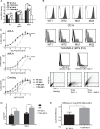Inefficient TLR4/MD-2 heterotetramerization by monophosphoryl lipid A
- PMID: 23638128
- PMCID: PMC3637451
- DOI: 10.1371/journal.pone.0062622
Inefficient TLR4/MD-2 heterotetramerization by monophosphoryl lipid A
Abstract
Synthetic forms of E. coli monophosphoryl lipid A (sMLA) weakly activate the MyD88 (myeloid differentiation primary response protein) branch of the bifurcated TLR4 (Toll-like receptor 4) signaling pathway, in contrast to diphosphoryl lipid A (sDLA), which is a strong activator of both branches of TLR4. sMLA's weak MyD88 signaling activity is apparent downstream of TLR4/MyD88 signaling as we show that sMLA, unlike sDLA, is unable to efficiently recruit the TNF receptor-associated factor 6 (TRAF6) to the Interleukin-1 receptor-associated kinase 1 (IRAK1). This reduced recruitment of TRAF6 explains MLA's lower MAPK (Mitogen Activated Protein Kinase) and NF-κB activity. As further tests of sMLA's ability to activate TLR4/Myeloid differentiation factor 2 (MD-2), we used the antibody MTS510 as an indicator for TLR4/MD-2 heterotetramer formation. Staining patterns with this antibody indicated that sMLA does not effectively drive heterotetramerization of TLR4/MD-2 when compared to sDLA. However, a F126A mutant of MD-2, which allows lipid A binding but interferes with TLR4/MD-2 heterotetramerization, revealed that while sMLA is unable to efficiently form TLR4/MD-2 heterotetramers, it still needs heterotetramer formation for the full extent of signaling it is able to achieve. Monophosphoryl lipid A's weak ability to form TLR4/MD-2 heterotetramers was not restricted to synthetic E. coli type because cells exposed to a biological preparation of S. minnesota monophosphoryl lipid A (MPLA) also showed reduced TLR4/MD-2 heterotetramer formation. The low potency with which sMLA and MPLA drive heterotetramerization of TLR4/MD-2 contributes to their weak MyD88 signaling activities.
Conflict of interest statement
Figures





Similar articles
-
MyD88-dependent SHIP1 regulates proinflammatory signaling pathways in dendritic cells after monophosphoryl lipid A stimulation of TLR4.J Immunol. 2011 Apr 1;186(7):3858-65. doi: 10.4049/jimmunol.1001034. Epub 2011 Feb 21. J Immunol. 2011. PMID: 21339365 Free PMC article.
-
The attenuated inflammation of MPL is due to the lack of CD14-dependent tight dimerization of the TLR4/MD2 complex at the plasma membrane.Int Immunol. 2014 Jun;26(6):307-14. doi: 10.1093/intimm/dxt071. Epub 2013 Dec 31. Int Immunol. 2014. PMID: 24380872
-
Selective activation of the p38 MAPK pathway by synthetic monophosphoryl lipid A.J Biol Chem. 2009 Nov 13;284(46):31982-91. doi: 10.1074/jbc.M109.046383. Epub 2009 Sep 15. J Biol Chem. 2009. PMID: 19759006 Free PMC article.
-
Monophosphoryl lipid A induces protection against LPS in medullary thick ascending limb through induction of Tollip and negative regulation of IRAK-1.Am J Physiol Renal Physiol. 2019 Sep 1;317(3):F705-F719. doi: 10.1152/ajprenal.00170.2019. Epub 2019 Jun 26. Am J Physiol Renal Physiol. 2019. PMID: 31241993 Free PMC article.
-
Recognition of lipid A variants by the TLR4-MD-2 receptor complex.Front Cell Infect Microbiol. 2013 Feb 12;3:3. doi: 10.3389/fcimb.2013.00003. eCollection 2013. Front Cell Infect Microbiol. 2013. PMID: 23408095 Free PMC article. Review.
Cited by
-
Characterization of Turbo, a TLR Ligand-based Adjuvant for Glycoconjugate Vaccines.Immunohorizons. 2024 Aug 1;8(8):527-537. doi: 10.4049/immunohorizons.2400040. Immunohorizons. 2024. PMID: 39093309 Free PMC article.
-
Novel synthetic toll-like receptor 4/MD2 ligands attenuate sterile inflammation.J Pharmacol Exp Ther. 2014 Aug;350(2):330-40. doi: 10.1124/jpet.114.214312. Epub 2014 Jun 3. J Pharmacol Exp Ther. 2014. PMID: 24893985 Free PMC article.
-
Kdo2 -lipid A: structural diversity and impact on immunopharmacology.Biol Rev Camb Philos Soc. 2015 May;90(2):408-27. doi: 10.1111/brv.12114. Epub 2014 May 16. Biol Rev Camb Philos Soc. 2015. PMID: 24838025 Free PMC article. Review.
-
Rational Vaccine Design in Times of Emerging Diseases: The Critical Choices of Immunological Correlates of Protection, Vaccine Antigen and Immunomodulation.Pharmaceutics. 2021 Apr 6;13(4):501. doi: 10.3390/pharmaceutics13040501. Pharmaceutics. 2021. PMID: 33917629 Free PMC article. Review.
-
The immunobiology of toll-like receptor 4 agonists: from endotoxin tolerance to immunoadjuvants.Shock. 2013 Dec;40(6):451-62. doi: 10.1097/SHK.0000000000000042. Shock. 2013. PMID: 23989337 Free PMC article. Review.
References
-
- Garcon N, Chomez P, Van MM (2007) GlaxoSmithKline Adjuvant Systems in vaccines: concepts, achievements and perspectives 1. Expert Rev Vaccines 6: 723–739. - PubMed
-
- Casella CR, Mitchell TC (2008) Putting endotoxin to work for us: monophosphoryl lipid A as a safe and effective vaccine adjuvant. Cell Mol Life Sci 65: 3231–3240 10.1007/s00018-008-8228-6 [doi]. - DOI - PMC - PubMed
-
- Ribi E, Parker R, Strain SM, Mizuno Y, Nowotny A, et al. (1979) Peptides as requirement for immuno therapy of the guinea-pig line-10 tumor with endotoxins. Cancer Immunol Immunother 7: 43–58.
-
- Mata-Haro V, Cekic C, Martin M, Chilton PM, Casella CR, et al. (2007) The vaccine adjuvant monophosphoryl lipid A as a TRIF-biased agonist of TLR4. Science 316: 1628–1632 316/5831/1628 [pii]; 10.1126/science.1138963 [doi]. - DOI - PubMed
-
- Thompson BS, Chilton PM, Ward JR, Evans JT, Mitchell TC (2005) The low-toxicity versions of LPS, MPL adjuvant and RC529, are efficient adjuvants for CD4+ T cells. J Leukoc Biol 78: 1273–1280 jlb.0305172 [pii]; 10.1189/jlb.0305172 [doi]. - DOI - PubMed
Publication types
MeSH terms
Substances
Grants and funding
LinkOut - more resources
Full Text Sources
Other Literature Sources
Research Materials

